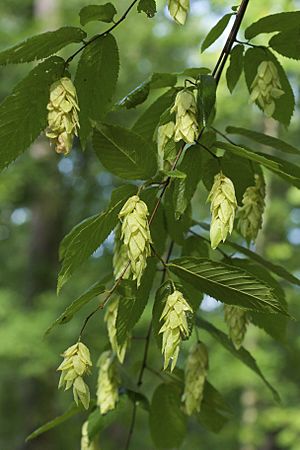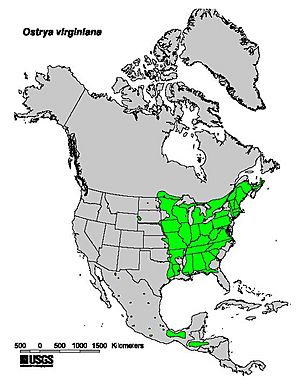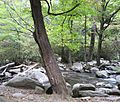American hophornbeam facts for kids
Quick facts for kids American hophornbeam |
|
|---|---|
 |
|
| A hophornbeam branch with the characteristic hop-resembling fruits in early summer | |
| Conservation status | |
| Scientific classification | |
| Genus: |
Ostrya
|
| Species: |
virginiana
|
 |
|
| Generalized native range | |
| Synonyms | |
|
|
The American hophornbeam (scientific name: Ostrya virginiana) is a cool tree that grows naturally in eastern North America. You can find it from Nova Scotia in Canada, all the way west to southern Manitoba and eastern Wyoming. It also grows southeast to northern Florida and southwest to eastern Texas. Some people think the trees found in Mexico and Central America are the same species, while others believe they are a slightly different kind.
This tree has a few other common names, like eastern hophornbeam, hardhack (especially in New England), ironwood, and leverwood.
Contents
What Does the American Hophornbeam Look Like?
The American hophornbeam is a small deciduous tree. This means it loses its leaves every autumn. It usually grows up to 18 meters (about 60 feet) tall. Its trunk can be about 20 to 50 centimeters (8 to 20 inches) wide.
Bark and Branches
The bark on older trees is brown to gray-brown. It looks a bit shaggy because it has narrow plates that flake off. Younger twigs and branches are smoother and gray. Very young twigs might have tiny hairs, but these usually fall off by the next year.
Leaves
The leaves are oval-shaped with a pointed tip. They are about 5 to 13 centimeters (2 to 5 inches) long and 4 to 6 centimeters (1.5 to 2.5 inches) wide. They have veins that look like a feather, and their edges are double-toothed, meaning they have small teeth along the main teeth. The top side of the leaf is mostly smooth, while the bottom side might have a few hairs.
Flowers and Fruits
The flowers of the American hophornbeam are called catkins. They look like long, hanging spikes. These catkins appear in early spring, at the same time the new leaves start to grow.
- The male catkins are 2 to 5 centimeters (about 1 to 2 inches) long and usually hang in groups of one to four.
- The female catkins are smaller, about 8 to 15 millimeters (0.3 to 0.6 inches) long, and each one has 10 to 30 tiny flowers.
After the female flowers are pollinated, they turn into small nuts. Each nut is about 3 to 5 millimeters (0.1 to 0.2 inches) long. These nuts are completely covered by a papery, sac-shaped wrapper called an involucre. This wrapper is about 10 to 18 millimeters (0.4 to 0.7 inches) long and 8 to 10 millimeters (0.3 to 0.4 inches) wide. The involucre starts out greenish-white and turns dull brown as the fruit ripens. These papery sacs look a bit like the hops used to make beer, which is how the tree got its "hophornbeam" name!
How to Tell it Apart from Similar Trees
The American hophornbeam looks a lot like its close relative, the American hornbeam. But you can easily tell them apart! The American hophornbeam has shaggy, peeling bark, while the American hornbeam has smooth bark. Also, the nuts of the American hornbeam are in open, three-lobed wrappers, not fully enclosed sacs.
Types of American Hophornbeam
There are two main types, or subspecies, of American hophornbeam:
- Ostrya virginiana subsp. guatemalensis: This type is found in central and southern Mexico, Guatemala, Honduras, and El Salvador.
- Ostrya virginiana subsp. virginiana: This type grows in the eastern half of the United States and eastern Canada.
Some trees along the Atlantic coast have slightly smaller leaves. Sometimes, these are considered a separate variety.
Ecology: Who Eats It?
The buds and catkins of the American hophornbeam are an important food source in winter for some birds, especially the ruffed grouse. The small nuts and buds are also eaten by other birds, deer, and rabbits.
Uses of the American Hophornbeam
People use the American hophornbeam in several ways:
- Ornamental Plant: It's sometimes planted in gardens and parks because it's a nice-looking tree. It can even be used as a street tree.
- Wood: The wood from this tree is very strong and tough. Because of this, it's often used to make tool handles and fence posts.
- Bows: Its wood is very dense and can handle a lot of pressure. This makes it an excellent material for building wooden longbows for archery!
Images for kids
-
Male catkins hanging from the branches in spring (United States Botanic Garden)
See also
 In Spanish: Ostrya virginiana para niños
In Spanish: Ostrya virginiana para niños







